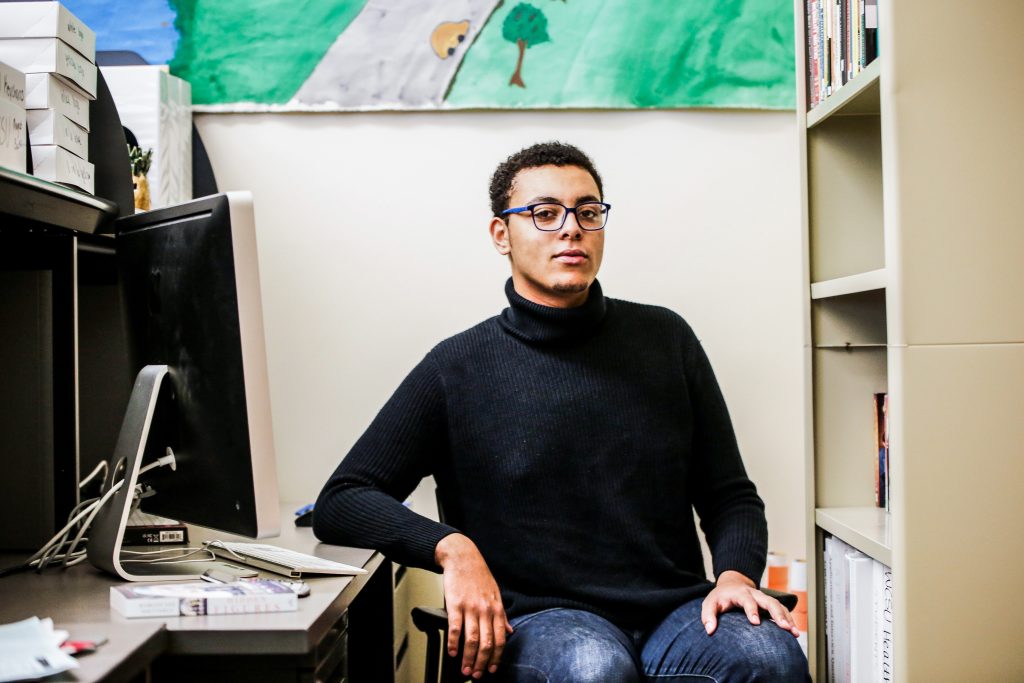After years of declining membership, organized labor reaches out to a younger generation
Photographed by Katie Scheidt
Kevin Gundlach began developing tendinitis about a year after his high school graduation. While most people see this condition when they’re older than 40, inflamed tendons and sharp pain came early for him and many of his coworkers.
He was laboring in a local non-unionized factory, which he describes as “oppressive toward workers.” Gundlach, at 19 years old, didn’t know what a union was.
“None of us knew what unions were. Some people died. [There were] high injury rates after two years — people started developing tendinitis, carpal tunnel things like that,” Gundlach says. “It was awful, atrocious working conditions.”
Most people did not stay at the factory for more than two years. Gundlach lasted a little more than a year, leaving when a doctor told him to because of health concerns. He moved, and now, nearly 30 years later, he oversees organized labor in 11 Wisconsin counties as president of the South Central Federation of Labor, AFL-CIO. He’s led the organization during what might be Wisconsin’s most tumultuous period for organized labor.
Following a nearly 40 percent drop in union membership since 2010, Gundlach and other leaders throughout the state are figuring out ways to best connect with new groups, including younger Wisconsin workers, in an effort to boost connections throughout the community and avoid gaps in awareness in the next generation of labor.
 Gundlach, now 50, grew up in a non-union home in Washington County, which is just north of Milwaukee. His grandparents had been in a union — an association of workers who together guard and further their workplace rights and interests.
Gundlach, now 50, grew up in a non-union home in Washington County, which is just north of Milwaukee. His grandparents had been in a union — an association of workers who together guard and further their workplace rights and interests.
The one-generation gap in union membership left Gundlach unaware of organized labor’s existence. So, he worked low-wage jobs that came with risks of injury. With union density in Wisconsin significantly dipping since 2010, Gundlach is worried the next generation of workers might be faced with the same struggles.
“The younger generations, yeah, they may not see the value,” Gundlach says. “They might think, ‘Oh, this is a dinosaur, it’s archaic. Unions are dead, that’s what we see in the media. Unions are under attack. What’s the point?’ All those things. I think that is a concern.”
The decline of union membership in Wisconsin is often traced to Gov. Scott Walker’s administration and the effects of two pieces of legislation: Act 10, which came in 2011 and is also known as the “Wisconsin Budget Repair Bill,” and a 2015 “right-to-work” law. Proponents of these measures say they provide workers with more flexibility and help balance the state’s budget.
“We can’t expect our children or our grandchildren to pay off the debts of the state,” Walker said in a February 2011 press conference announcing the budget repair bill. “We have to get things under control so that we can continue to have a stable government — a government that is stable not only for the services we provide, but ultimately it sends a message to our employers in this state that this is a good place to invest in and grow in.”
“This bill will be a change in terms of state employees not being required to be a part of their union and not being required to have payroll deductions,” Walker said. “They can opt to be a part of a union, but they don’t have to have those dues.”
Opponents have assailed the pieces of legislation as attacks on organized labor in the state, aimed at reducing union membership and subsequently minimizing their influence. Following the passing of both bills, Wisconsin union membership plummeted.
Nearly 15 percent of public and private workers in Wisconsin were members of unions in 2006, according to data from the U.S. Bureau of Labor Statistics. That was about three points higher than the national rate at the time and remained steady until 2010. In terms of union density, Wisconsin looked like other Midwestern states in 2010, closely mirroring both Minnesota and Michigan, two states that hovered around 15 percent.
Then Wisconsin’s union membership started to drop. By 2016, the portion of Wisconsin’s workforce in unions was roughly 8 percent — a decline of nearly 40 percent since 2006 and now about 3 percentage points lower than the national rate. In 2014, Walker said Act 10 saved taxpayers some $3 billion, according to the Milwaukee Journal Sentinel, a claim Politifact rated as “mostly true.”
“Now, we have to play defense and protect what we have and do what I would call internal organizing,” Gundlach says. “I think there needs to be — and there is with some unions — a plan to organize more workers into unions so that they know that’s the way out.”
Decades earlier, David Newby, a longtime leader of labor in Wisconsin, worked to do the same thing: reach out to more people outside of labor.
Newby has seen significant changes to organized labor in Wisconsin, both good and bad. He’s been involved with unions in the state since the mid-1970s, first with UW-Madison’s Teaching Assistants’ Association, which was the first graduate student workers union in America and a group he continues to advise.
He eventually ran for leadership positions for the AFL-CIO in Dane County in the early 1980s. When he took over, he describes organized labor in the county as separate from the rest of the community and concerned largely about issues that only affect unions.
“There was a new labor movement in town, and it was not isolated, huddling by itself,” says Newby, who later served as president of the state AFL-CIO for more than two decades. “We wanted to be a part of the community, and we wanted to build coalitions with other progressive groups.”
With shrinking union membership today, Gundlach has been working hard to avoid these same pitfalls. He’s tried to make what have typically been union spaces into more community-based spaces. The field outside the organization’s office has hosted many events, ranging from a middle school ultimate frisbee team’s practices to Madison’s Juneteenth celebration.
The hope is to be present in the community, extending the value of unions to others, even those in the working class who are attending college.

During his freshman year at UW-Madison, Zaakir Abdul-Wahid, now a member of UW-Madison’s Working Class Student Union, says he opened a credit card to pay for University Housing. Otherwise, he wouldn’t have been able to enroll in classes. Since then, he says there hasn’t been a semester when he’s been able to buy the textbooks for each of his classes.
“A lot of people don’t understand that actual layer of stress makes it so much harder to be able to focus on school and to focus on real things,” Abdul-Wahid says. “Because if I don’t have money to pay rent — if I don’t have money to eat — I can’t worry about my classes.”

Abdul-Wahid is now a junior at UW-Madison. He grew up in Milwaukee in a family with a tight financial situation. And though his mother changed tax brackets since then, he says his money situation is still difficult, and he’s sometimes late in paying his rent.
He knows of organized labor’s history in Wisconsin, but he says a lot of the information just isn’t “getting to enough students.”
“I think a lot of students are really unaware of [unions], especially with the [dining hall] staff and a lot of the university staff,” Abdul-Wahid says. “I think there’s a big disconnect, and they don’t realize that they do actually have the ability to ask for more or less.”
Many people involved with organized labor are working to get union history into schools — starting as young as elementary school. In December 2009, Wisconsin became the first state in the country to require public schools to incorporate the history of organized labor as a part of social studies standards. Still, some have questioned how fully this has been implemented.
Some are trying to spread a map of pivotal moments in labor history, which started as a partnership between organized labor and UW-Madison students. The Wisconsin Labor History Society, which is dedicated to “preserving and telling the stories of workers and unions in Wisconsin,” has essay contests and scholarships to encourage students to write more about labor’s past.
Ken Germanson, 88, and president emeritus of the society, says education in schools about union history is still lacking. He says it’s vital union leaders continue reaching out to younger people because they “have to figure out how to organize the new generation of labor.”
One way they’re doing this is by going directly into schools. The Wisconsin Regional Training Partnership Big Step program goes to middle and high schools to reach out to students about the option of joining the building and construction trades. Gundlach says unions in the building trades pay for the program to exist.
The Big Step program connects students with other organizations to pay for schooling and training and then puts them on a list to get a job. Gundlach says even though unions need to do a better job of publicizing the program, it still turns many students’ heads when they learn about it.
Gundlach has seen firsthand the impact this education, and the idea of unions, can have on young students.
One day, a couple of years ago, an elementary school class walked up to the labor temple, a building on Madison’s south side that houses the South Central Federation of Labor, AFL-CIO and many local unions. After showing the kids around the temple, the instructor of the class told Gundlach that he could take over as teacher.
So Gundlach did an exercise. He started by asking students to raise their hands if they liked going to the zoo. Though the students were reluctant at first, most hands soon shot up. Then he asked how they got there. Did they walk or take the bus? He quizzed the students on what lions ate, who took care of them and if they liked “The Lion King.”
Then he walked the students through how unions were involved in each step. Manufacturing union workers made the refrigerators and freezers that stored the meat that fed the lions. Members of another union repaired the roads to make them drivable. The stagehands union put on “The Lion King” musical. And the zookeepers are in a union, too.
At the end of the lesson, one student said, “My mommy works in a factory.”
“The teacher will say to me, ‘That’s the first time that kid was proud and ever said anything about her mom working in a factory,’” Gundlach says. “A worker is a worker is a worker. The value of all these jobs is, in my opinion, equitable.”

Peter Coutu is a senior double majoring in journalism and history. He was born on the east coast but moved to Wisconsin when he was young.
He transferred to UW-Madison after spending his freshman year at the University of Michigan, where he was thinking of majoring in business. He quickly learned that field wasn’t for him.
During his first two years on campus, he spent much of his time in Vilas Hall, working for The Daily Cardinal. Now, he’s writing for Isthmus and The Capital Times. Peter is set to graduate in May and hopes to work for a daily local newspaper after college.

